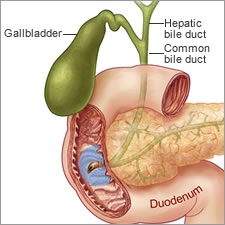Gallbladder Surgery in Atlanta
 As one of the most commonly performed surgeries in the U.S., gallbladder surgery, or cholecystectomy, has enjoyed many technological advances over the years. In fact, most cholecystectomies today are laparoscopic surgeries. These particular surgeries are called laparoscopic cholecystectomies.
As one of the most commonly performed surgeries in the U.S., gallbladder surgery, or cholecystectomy, has enjoyed many technological advances over the years. In fact, most cholecystectomies today are laparoscopic surgeries. These particular surgeries are called laparoscopic cholecystectomies.
What the Gallbladder Does
The purpose of the gallbladder is to collect bile from the liver to help people digest fats. The removal of the gallbladder, though does not diminish the ability of most people to digest food.
People who suffer from gallstones, have gallbladder disease, or gallbladder cancer may require gallbladder surgery, though a full medical history is conducted before considering gallbladder surgery.
Laparoscopic Cholecystectomy
This minimally invasive procedure allows the surgeon to make four small incisions in your abdomen in order to insert a small video camera through one incision and surgical tools through the others.
The camera allows the surgeon to see what’s going on without the need for the large incision open surgery requires. Once the gallbladder is successfully removed, the surgeon conducts an x-ray or ultrasound to see if there are abnormalities in the bile duct.
If problems are discovered, the surgeon remedies them before suturing the incisions. Once the incisions are closed, the patient is taken to the recovery area for one to two hours before being released.
Most people are able to leave the day of the surgery, though some may require an overnight stay before being released. Typically, the surgeon wants to see that a patient is able to walk unassisted and eat and drink without pain. Full recovery from laparoscopic cholecystectomy may take a week.
Open Cholecystectomy
Unfortunately, not everyone is an ideal candidate for the laparoscopic procedure. Previous surgeries, scar tissue, and other complications may require a larger incision or open surgery.
If this is the case, the surgeon will make a six to seven-inch incision in the right side of the abdomen and below the ribs. The surgeon then pulls back muscle and tissue in order to gain access to the liver and gallbladder.
Next, the surgeon removes the gallbladder, and sutures the incision before taking the patient to the recovery area.
Open cholecystectomy is a more extensive surgery than a laparoscopic cholecystectomy. An open cholecystectomy requires more time for recovery than the laparoscopic cholecystectomy. Most patients will spend two or three days in the hospital before returning home, where it can take as many as four weeks to completely recover.
Risks or Complications from Gallbladder Surgery
All surgeries carry some degree of risk. Most laparoscopic patients, though, are able to return to normal activities with few, if any, complications arising. They include bleeding, blood clots, infections, and pneumonia, as well as incidental injury to adjacent structures in the abdomen. In rare instances, bile leakage into the abdomen may occur.


